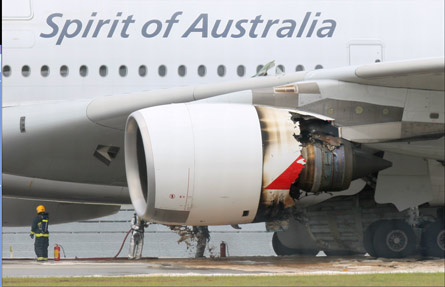Qantas has made clear that it is not happy with Rolls-Royce's handling of the Airbus A380 engine failure crisis, and has prepared the way for court action against the engine manufacturer.
The airline says it will take legal action unless the two parties can agree a settlement over losses resulting from grounding of its six A380s after the uncontained failure of a Trent 900 on 4 November. This failure forced a Qantas A380 to make an emergency landing at Singapore, the airframe having received considerable damage from high-energy escaping engine fragments.
On 2 December the Australian Transport Safety Bureau (ATSB) provided more insight into the issues behind the failure, and recommended an additional one-off inspection within two flight cycles. This extra inspection requirement was advised following an examination, at R-R's Derby plant, of the failed engine and others which, during the initial inspection regime, showed evidence of the same problem.
 |
|---|
© PA |
Industry sources say that the problem affects only the "A mod" and "B mod" Trent 900 variants. The latest variant, the "C mod", is not subject to the latest findings. This appears to indicate that R-R identified the fault and fixed it on the latest engine variant.
The first Trent 900 that Lufthansa had to change was an early variant, but it is not known precisely when R-R applied the modifications, and customers have become increasingly unhappy with the way the manufacturer has handled the entire incident.
Sources say that R-R's chief executive John Rose has visited Singapore and other Asian countries to try to explain the situation to both existing and future A380 operators. However, the carriers are making it clear that they expect the engine manufacturer to be more open about the problem.
In the first public details about the likely causes of the 4 November incident, the ATSB says that there was "fatigue cracking" in a stub pipe that feeds oil into the high-pressure/intermediate pressure bearing structure.
This led to an oil leakage, and subsequently an oil fire and the engine failure, it explains, adding: "While the analysis of the engine failure is ongoing, it has been identified that the leakage of oil into the HP/IP bearing structure buffer space, and a subsequent oil fire within that area, was central to the engine failure and IP turbine disc liberation event."
The ATSB statement continues: "Further examination of the cracked area has identified the axial misalignment of an area of counter-boring within the inner diameter of the stub pipe; the misalignment having produced a localised thinning of the pipe wall on one side. The area of fatigue cracking was associated with the area of pipe wall thinning."
Qantas and Singapore Airlines grounded their A380s as a result. SIA resumed services soon after the European Aviation Safety Agency issued guidelines for additional inspections. Qantas restarted A380 flights on 27 November.
After discussions with Qantas, R-R and Australia's Civil Aviation Safety Authority, the ATSB has now recommended a more detailed one-off inspection of Trent 900 engines. These should be conducted within two flight cycles, and supplement the 20-cycle inspection mandated by EASA after the first incident.
The findings apply to all "relevant" Trent 900 variants operated worldwide, so SIA and Lufthansa are also affected. "We have begun the inspections and are complying with the recommendations, which are intended to ensure the continued safe operation of the fleet," says SIA.
Qantas does not expect any additional impact on international services, but says that it "will determine any further response after it has finalised the inspection regime and consulted with both regulators and the manufacturer".
Source: Flight International























